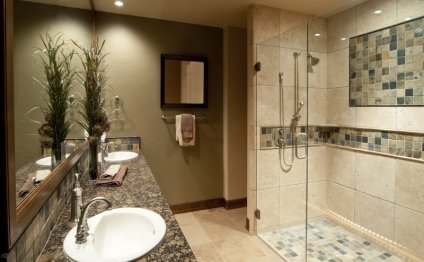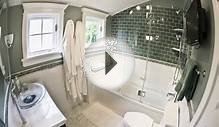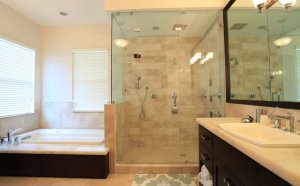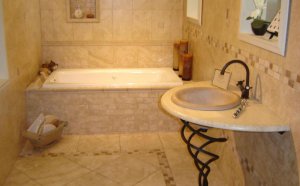
Cost of Renovating a small bathroom
A small bathroom remodel can be deceptive. Worry too much and you may be delightfully surprised that you pulled it off with such ease. Underthink it and you may get bitten in the end.
Small bathroom remodels have both elements. A half-bath remodel can be a lark-it's all the fun stuff like paint, towel bars, vanity tops, and cool sinks. Remodeling your master small-bathroom can result in weeks of showering at your neighbor's house and family feuds.
But it doesn't have to be like that. See how:
Do You Have a Small Bathroom?
A small bathroom is defined as being about 50 square feet or smaller. Widths and lengths will vary, but this translates to a rectangular space, roughly 5 feet by 10 feet, 6 feet by 8 feet, or thereabouts.
Amenities (or lack of) do not define a small bathroom. It can be a:
- : Little more than a sink, toilet, and a door for privacy. No bathing facilities. A powder room is a half-bathroom: it offers half of the amenities of a full bath.
- : Full-service bathroom, with sink, toilet, and shower or shower/tub combination. This is a bathroom that you do not use for your daily needs. For example, it might be a kids' bathroom repurposed for adult use after the kids have left the house.
- : A full-service bathroom that you use on a daily basis. Often, this is the only bathroom in the house, and everyone uses it. Because this is your "daily driver, " it gets heavy use and thus may require more remodeling efforts.
Different From a Large Remodel. But Not By Much.
It is not difficult to figure out that small bathrooms are easier to renovate than large bathrooms-fewer materials, lower costs, less space. Thirty square feet of porcelain tile is half the cost of 60 square feet. It stands to reason that costs would be less.
What is surprising is that, unless you have a half-bath, small bathrooms are not exponentially easier to renovate.
Most costs are devoted to rehabbing your shower, tub, or shower/tub. Bathing facilities are spatially and functionally the same in small bathrooms as in large bathrooms. The only difference is that you may be more willing to accept lower-grade, less expensive materials in a small, second bathroom than you would in your daily main bathroom.
1. Define Needs: Who Will Use This and Why?
Define who will be using the bathroom. When you start with the "who, " then the "why" usually becomes apparent:
- You: If this is a small bathroom that happens to be your master bathroom, you use it for everything, from applying makeup to using the toilet to showering. You may want to splurge on cabinets and higher-end materials. After all, you will have to look at this bathroom at least twice a day for many years.
- Children: Small bathrooms for children may endure decades of use and abuse. Small kids need a bathtub; showers are useless. Floors are most important, since little kids can flood bathroom floors with water simply by stepping out of the tub.
- Overnight Guests: If this bathroom is for overnight guests, you can may want to skimp on the quality of materials. You will not need increased storage space for guests, either.
- Day Guests: For a powder room, you need little more than a sink, toilet, and towel bar. The sink can even be a decorative sink-a vessel sink, for example-because guests' only need is to wash their hands, not to brush teeth.
- Elderly or Disabled: This is a special class of users, as additional or augmented features such as grab bars, lower counters, and no-slip flooring are needed. If your small bath can accommodate it, a walk-in bathtub is a great aid for elderly or disabled persons.
2. Even Small Bathrooms Need Planning
Do you think that small bathroom remodels do not require planning? If so, you may be confusing floor-planning with comprehensive planning.
In most small bathrooms, the floor plan is a given. You may be able to shift the vanity a few inches, but other elements-toilet, sink, and sink/tub-remain firmly in place. In most cases, it makes the most sense to keep these three services where they are.
Backsplash tile, wall tile, flooring, and paint color work together to form a unified bathroom. Because of this, you will want to consider all of these elements in the same mode of thought, rather than sequentially and piece-meal.
3. Will You Do It Yourself or Hire a Pro? Or Both?
- Do It Yourself: A small bathroom is a great place to hone your remodeling skills. Any kind of secondary bathroom-guest bathroom or powder room-is ripe for the DIY treatment. With the luxury of time, you can get to the project whenever your life permits. But if this is a full service bathroom and you have no alternate baths in the house, consider downtime. Where will you bathe? Often, this is the tipping point that forces DIYers to call in a remodeling company.
- Pro: Electrical and plumbing are two trades that have a steep learning curve. If your remodel involves re-routing wires or plumbing, you may want to call in professional remodelers. Minor electrical and plumbing projects, like installing a faucet or adding a GFCI outlet, are homeowner-friendly. A small bathroom renovation, performed by a remodeling contractor and using builder grade materials, might cost as little as $18, 000.
- DIY/Pro Combination: Most contractors are amenable to you doing some of the work yourself (after all, this is your house). But you need to stay out of their way. Do not expect to be working alongside them. Schedule your sweat equity work so that you do it either before they start the entire project or after they have finished. Interspersing your work with theirs only leads to confusion. Classic examples of this DIY/pro combination: you demo the bathroom before they start; you paint the walls after they have finshed.
4. Demolition: Peeling Back the Layers
The degree of bathroom demolition you do depends on the scale of your project. If you need to fully demo to the studs, budget at least three full days for this. It is a more involved process than you might imagine.
Rent a roll-off dumpster for your driveway. A great alternative to losing your driveway to a roll-off is to pile debris in the drive and have a hauling company take it all away.
If your bathroom pre-dates 1978, be careful for lead-based paint dangers.
5. Plumbing and Electrical
With walls open, electrical and plumbing install first. Rough-in the plumbing for toilet, shower, and bathtub.
The electrician can work concurrently with the plumber, though schedule them for different days due to space considerations.
Permits are required for both. Also, two inspections done: first, at the rough-in stage; second, after the walls have been closed up. If you hire a contractor, he/she will do everything permit- and inspection-related for you.
6. Flooring, Vanity and Sink, Cabinets
If you are in a time crunch or feel uncomfortable with your abilities, the contractor will continue with:
7. The Fun Part: Hardware, Accessories, Decorative Items
RELATED VIDEO



Share this Post
Related posts
Cost to Renovate small bathroom
Ideas, costs, tips and plans - the information you need for a successful Small Bathroom Remodeling project Homeowners have…
Read MoreRenovations for small bathroom
The bathroom after being remodeled The remodeled bathroom has an updated look and is highly functional. The bathroom before…
Read More











